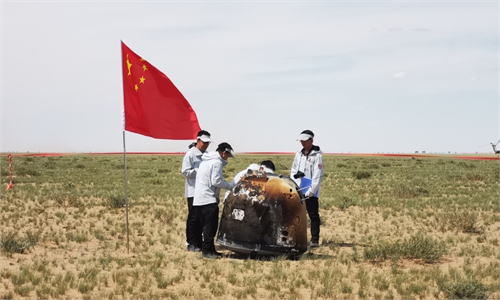Chang’e-6 lunar samples to be open for global application, aimed at advancing moon research

The returner of the Chang'e-6 lunar probe is opened during a ceremony at the China Academy of Space Technology under the China Aerospace Science and Technology Corporation in Beijing, capital of China, June 26, 2024. The returner of the Chang'e-6 lunar probe was opened at a ceremony in Beijing on Wednesday afternoon. During the ceremony at the China Academy of Space Technology under the China Aerospace Science and Technology Corporation, researchers opened the returner and examined key technical indicators.(Photo: Xinhua)
The first batch of lunar samples from the far side of the moon, collected by China's Chang'e-6 mission, is expected to be distributed to domestic scientists by the end of 2024, with availability for international researchers to follow. These samples are anticipated to further deepen mankind's understanding of the moon.
The CCTV news reported on Tuesday that the Chang'e-6 lunar scientific research samples will be distributed by means through an open application system. Researchers can access information and apply for the samples through the Lunar and Deep Space Exploration Scientific Data and Sample Release System on China's Lunar and Deep Space Exploration website.
Scientists around the world are keenly interested in this only batch of lunar samples, which are expected to update mankind's understanding of the Moon, Li Chunlai, deputy chief designer of the mission, told the CCTV news.
Li noted that the Chang'e-6 mission team has completed the unsealing, partitioning, processing, preparation, and preliminary analysis of the samples.
During the process of assembling the samples, the team observed that the lunar samples brought back by Chang'e-6 had more spalls than those from Chang'e-5. After preliminary analysis, scientists believe this is likely due to the fact that Chang'e-6's sampling point is located on the edge of an impact crater, which bears some relation to the spatter generated by the collision, Liu Jianjun, deputy chief commander of the ground application system of the mission, told the CCTV news.
The samples also contain a greater variety of minerals than those collected from the Chang'e-5 lunar samples, and they are of a finer texture, Liu added.
NASA spokesperson Faith McKie told the media that while China worked with the European Space Agency, and France, Italy, and Pakistan on this mission, "NASA wasn't invited to take part in the moon probe." NASA also didn't receive "any direct invitation" to study China's moon rocks, after it welcomed all scientists from around the world to apply to study them, McKie told NatSec Daily in late June.
Wang Yanan, chief editor of Beijing-based Aerospace Knowledge magazine, said making such claims is "just being ridiculous," as it is the US, not China, who is blocking this opportunity.
"China's application process, as announced, is wide open to global research institutes, and it never banned US participation in the research of lunar soils. However, it is the Wolf Amendment of the US that restricts any institution that receives government funding to collaborate with China in the field of space," Wang told the Global Times on Tuesday.
If these US institutions want to apply for the Chang'e-6 samples, they must obtain special approval from the US Congress due to the presence of this amendment, Wang explained. Currently, no such "green light" is in sight from Congress.
"This has excluded the vast majority of research institutions capable of lunar soil research in the US. And since most of the more capable ones are funded by the US government and therefore banned by its own laws from participating, it will significantly reduce the chances of the US to obtain the precious lunar soils," Wang noted.
Responding to NASA's "sour grapes" rhetoric, Chinese Foreign Ministry spokesperson Mao Ning told the Global Times in July that China is open to having space exchanges with the US, but the US side "seems to have forgotten to mention its domestic legislation such as the Wolf Amendment. The real question is whether US scientists and institutions are allowed by their own government to participate in cooperation with China," Mao said.
Considering that the lunar samples are very valuable, to ensure their safety, the security measures for the storage room are comparable to those of a vault, and the entire outer layer of the room is covered with a steel plate structure, said Zhou Qin, a deputy chief designer of the ground application system of the mission.
The storage facility is a high-level clean room, where all air flowing into is purified by a filter cartridge. The room also meets high environmental requirements, maintaining a constant temperature and humidity environment, Zhou mentioned.



